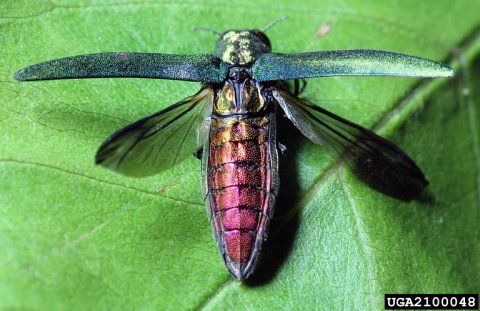
Bad news for Kingston's ash trees: Last week, the USDA found emerald ash borer-infested trees in the city. Alderman Bill Reynolds, who blogs at billreynolds.wordpress.com, has a press release from Kingston environmental educator Steve Noble:
New York State’s newest invasive threat has made its way to the City of Kingston. The Emerald Ash Borer (EAB), a non-native insect that feeds on Ash trees, has been found in the city limits. This is the first known location of the insect within the City of Kingston. However, it is believed the EAB is most likely present in other locations on private land in Kingston near East Kingston.
Recently, John D. Vandenberg and Mike Griggs, entomologists from the United States Department of Agriculture’s Agricultural Research Station in Ithaca, New York and Juli Gould, from the USDA’s Animal and Plant Health Inspection Service, identified Emerald Ash Borer infested Ash trees on Kingston’s parkland in the vicinity of Kingston Point Park. This was reported to the Regional Forester Jeff Wiegert and Kingston Environmental Educator Steve Noble who field checked the location.
The Emerald Ash Borer kills the Ash tree from the canopy down, usually within a five-year period. Ash trees comprise approximately 7% of New York State’s forests however are more predominate in urban areas as street trees, due to their ability to withstand urban conditions. This insect most likely traveled to Ulster County through the movement of firewood.
Mayor Sottile has asked Kingston Environmental Educator Steve Noble to coordinate the EAB response for the City of Kingston. Steve Noble has met with regional DEC Forester Jeff Wiegert and Cornell Cooperative Extension’s Teresa Rusinek to discuss Kingston’s response to this invasive insect.
“This bug will most likely kill all of Kingston’s Ash trees which are found along our streets, parkland and infrastructure and we must prepare for the cost of removal and replanting along with protecting life and property,” said Mayor James M. Sottile. Sottile is also directing city staff to look for grant opportunities to help Kingston respond to these difficult circumstances, which will allow for the City to reduce the impact on city taxpayers.
“The City will be working with the Kingston Tree Commission, Kingston Conservation Advisory Council, the NYS DEC, Cornell Cooperative Extension, the USDA, and many other local, state and federal agencies in order to create a community preparedness plan during the winter of 2011,” said Steve Noble.
One of the first steps is to identify Kingston’s Ash tree population, especially street trees, as they pose the most risk to infrastructure and the quality of life in neighborhoods. The City has launched an online Ash tree reporting site that will allow homeowners to learn about Ash trees while also providing a forum for community members to report Ash trees along their streets. Additionally, the City is looking for volunteers to conduct an Ash tree inventory later this fall and early winter. Currently, the City does not have an up to date tree inventory.
For more information, please visit Kingston Emerald Ash Borer Website at www.kingston-ny.gov and click on Parks and Recreation/Environmental Education.
Photo from InsectImages.org, by David Cappaert, Michigan State University.













